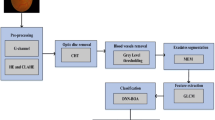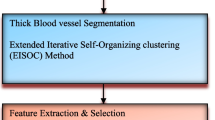Abstract
Diabetic retinopathy (DR) is one of the most prevalent genetic diseases in human and it is caused by damage to the blood vessels in the eye retina. If it is undetected and untreated at right time, it can lead to vision loss. There are many medical imaging and processing technologies to improve the diagnostic process of DR to overcome the lack of human experts. In the existing image processing methods, there are issues such as lack of noise removal, improper clustering segmentation and less classification accuracy. This can be accomplished by automatic diagnosis of DR using advanced image processing method. The cotton wool spot (CWS), hard exudates (HE) contains a common manifestation of many diseases in retina including DR and acquired immunodeficiency syndrome. In the present work, super iterative clustering algorithm (SICA) is proposed to identify the CWS, HE on retinal image. Feature-based medical image retrieval (FBMIR) datasets are utilized for this purpose. Noises present on the images and histogram-filtering technique is used to convert red, green, and blue (RGB) images into a perfect greyscale image without noise. After pre-processing, SICA is used to identify the CWS, HE detection on retinal images and eliminates unnecessary areas of interest. In the third stage, after detecting CWS and HE, various statistical features are extracted for further classification using deep assimilation learning algorithm (DALA). The performance of DALA technique is examined with various classification parameters like recall, precision, and F-measure. Finally, the false classification ratios are computed to compare the performance of the trained networks. The proposed method produces accurate detection of affected regions with an accuracy ratio of 98.5% and it is higher than the other conventional methods. This method may improve the accuracy of automatic detection and classification of eye diseases.











Similar content being viewed by others
References
Mahavir S, Suresh CT (2018) Genes and genetics in eye diseases: a genomic medicine approach for investigating hereditary and inflammatory ocular disorders. Int J Ophthalmol 11(1): 117–134 https://doi.org/10.18240/ijo.2018.01.20.
Gao XR (2019) Genetics and genomics of eye disease: advancing to precision medicine. Chapter. https://doi.org/10.1016/C2017-0-04270-2
David JG, Shalaw RS (2020) Variability in gene expression is associated with incomplete penetrance in inherited eye disorders. Genes 11(2): 179 https://doi.org/10.3390/genes11020179
Fakin A, Šuštar M, Brecelj J, Bonnet C, Petit C, Zupan A, Glavač D, Jarc-Vidmar M, Battelino S, Hawlina M (2019) Double hyperautofluorescent rings in patients with USH2A-retinopathy. Genes (Basel) 10(12):956. https://doi.org/10.3390/genes10120956.PMID:31766479;PMCID:PMC6947471
Habibi I, Falfoul Y, Todorova MG, et al. (2019) Clinical and genetic findings of autosomal recessive bestrophinopathy (ARB) [published correction appears in Genes (Basel). 2020 May 03;11(5):]. Genes (Basel) 10(12):953. (Published 2019 Nov 21). https://doi.org/10.3390/genes10120953
Padmasini N, Umamaheswari R, Kalpana R, Mohamed YS (2020) Comparative study of iris and retinal images for early detection of diabetic mellitus. J Med Imaging Health Inf 10: 316–325
Qiao L, Zhu Y, Zhou H (2020) Diabetic retinopathy detection using prognosis of microaneurysm and early diagnosis system for non-proliferative diabetic retinopathy based on deep learning algorithms. IEEE Access 8:104292–104302. https://doi.org/10.1109/ACCESS.2020.2993937
Jayanthi J, Lydia EL, Krishnaraj N et al (2020) An effective deep learning feature based integrated framework for iris detection and recognition. J Ambient Intell Human Comput. https://doi.org/10.1007/s12652-020-02172-y
Costa P, Galdran A, Smailagic A, Campilho A (2018) A weakly-supervised framework for interpretable diabetic retinopathy detection on retinal images. IEEE Access 6:18747–18758. https://doi.org/10.1109/ACCESS.2018.2816003
Savastano MC, Federici M, Falsini B, Caporossi A, Minnella AM (2018) Detecting papillary neovascularization in proliferative diabetic retinopathy using optical coherence tomography angiography. Acta Ophthalmol 96(3):321–323. https://doi.org/10.1111/aos.13166 (Epub 2016 Aug 6 PMID: 27495781)
Duh EJ, Sun JK, Stitt AW (2017) Diabetic retinopathy: current understanding, mechanisms, and treatment strategies. JCI Insight 2(14):e93751. https://doi.org/10.1172/jci.insight.93751.PMID:28724805;PMCID:PMC5518557
Safi H, Safi S, Hafezi-Moghadam A, Ahmadieh H (2018) Early detection of diabetic retinopathy. Surv Ophthalmol 63(5): 601–608 https://doi.org/10.1016/j.survophthal.2018.04.003
Amin J, Sharif M, Yasmin M, Ali H, Fernandes SL (2017) A method for the detection and classification of diabetic retinopathy using structural predictors of bright lesions. J Comput Sci 19:153–164. https://doi.org/10.1016/j.jocs.2017.01.002
Costa P, Campilho A (2017) Convolutional bag of words for diabetic retinopathy detection from eye fundus images. In: 2017 Fifteenth IAPR International Conference on Machine Vision Applications (MVA), Nagoya, 2017, pp. 165–168 https://doi.org/10.23919/MVA.2017.7986827.
Ting DSW, Cheung CY, Lim G, Tan GSW, Quang ND, Gan A, Hamzah H, Garcia-Franco R, San Yeo IY, Lee SY, Wong EYM, Sabanayagam C, Baskaran M, Ibrahim F, Tan NC, Finkelstein EA, Lamoureux EL, Wong IY, Bressler NM, Sivaprasad S, Varma R, Jonas JB, He MG, Cheng CY, Cheung GCM, Aung T, Hsu W, Lee ML, Wong TY (2017) Development and validation of a deep learning system for diabetic retinopathy and related eye diseases using retinal images from multiethnic populations with diabetes. JAMA 318(22):2211–2223. https://doi.org/10.1001/jama.2017.18152.PMID:29234807;PMCID:PMC5820739
Tjandrasa H, Putra RE, Wijaya AY, Arieshanti I (2013) Classification of non-proliferative diabetic retinopathy based on hard exudates using soft margin SVM. In: 2013 IEEE International Conference on Control System, Computing and Engineering, Mindeb, 2013, pp. 376–380, https://doi.org/10.1109/ICCSCE.2013.6719993.
Jie Z, Shi-Yun L (2011) Noise-removing algorithm for fluorescein angiogram of diabetic retinopathy. In: 2011 4th International Conference on Biomedical Engineering and Informatics (BMEI), Shanghai, pp. 418–421 https://doi.org/10.1109/BMEI.2011.6098232.
Robert NF (2004) Diabetic retinopathy. N Engl J Med 274:1344–1349. https://doi.org/10.1056/NEJM196606162742403
Toh KKV, Mat I (2010) Noise adaptive fuzzy switching median filter for salt-and-pepper noise reduction. IEEE Signal Process Lett 17(3):281–284. https://doi.org/10.1109/LSP.2009.2038769
Agurto C, Murray V, Barriga E, Murillo S, Pattichis M, Davis H, Soliz P (2010) Multiscale AM-FM methods for diabetic retinopathy lesion detection. IEEE Trans Med Imaging 29(2):502–512. https://doi.org/10.1109/TMI.2009.2037146
Niemeijer M, van Ginneken B, Russell SR, Suttorp-Schulten MS, Abràmoff MD (2007) Automated detection and differentiation of drusen, exudates, and cotton-wool spots in digital color fundus photographs for diabetic retinopathy diagnosis. Invest Ophthalmol Vis Sci 48(5):2260–2267. https://doi.org/10.1167/iovs.06-0996
Quellec G, Lamard M, Josselin PM, Cazuguel G, Cochener B, Roux C (2008) Optimal wavelet transform for the detection of microaneurysms in retina photographs. IEEE Trans Med Imaging 27(9):1230–1241. https://doi.org/10.1109/TMI.2008.920619.PMID:18779064;PMCID:PMC2567825
Philip S, Fleming AD, Goatman KA et al (2007) The efficacy of automated “disease/no disease” grading for diabetic retinopathy in a systematic screening programme. Br J Ophthalmol 91(11):1512–1517. https://doi.org/10.1136/bjo.2007.119453
He J, Shen L, Ai X , Li X (2019) Diabetic retinopathy grade and macular edema risk classification using convolutional neural networks. In: 2019 IEEE international conference on power, intelligent computing and systems (ICPICS), Shenyang, China, 2019, pp. 463–466, https://doi.org/10.1109/ICPICS47731.2019.8942426.
Abbas Q, Fondon I, Sarmiento A et al (2017) Automatic recognition of severity level for diagnosis of diabetic retinopathy using deep visual features. Med Biol Eng Comput 55:1959–1974. https://doi.org/10.1007/s11517-017-1638-6
Wong TY, Bressler NM (2016) Artificial intelligence with deep learning technology looks into diabetic retinopathy screening. JAMA 316(22):2366–2367. https://doi.org/10.1001/jama.2016.17563
Quellec G, Charrière K, Boudi Y, Cochener B, Lamard M (2017) Deep image mining for diabetic retinopathy screening. Med Image Anal 39:178–193. https://doi.org/10.1016/j.media.2017.04.012
Quellec G, Lamard M, Josselin PM, Cazuguel G, Cochener B, Roux C (2008) Optimal wavelet transform for the detection of microaneurysms in retina photographs. IEEE Trans Med Imaging 27(9):1230–1241. https://doi.org/10.1109/TMI.2008.920619
Angadi S, Ravishankar M (2015) Detection and classification of microaneurysms using DTCWT and log gabor features in retinal images. In: Proceedings of the 3rd International Conference on Frontiers of Intelligent Computing: Theory and Applications (FICTA) 2014, Vol.328, pp 589–596. https://doi.org/10.1007/978-3-319-12012-6_65.
Khojasteh P, Aliahmad B, Kumar DK (2018) Fundus images analysis using deep features for detection of exudates, hemorrhages and microaneurysms. BMC Ophthalmol. https://doi.org/10.1186/s12886-018-0954-4
Nimbarte NM, Mushrif MM, Belsare AD (2020) Lesion feature detection of retinopathy images. Int J Innov Technol Explor Eng (IJITEE) 9(3):2278–3075. https://doi.org/10.35940/ijitee.B7941.019320
Lavanya R, Rajini GK (2020) Fundus image analysis to detect abnormalities in diabetic retinopathy using computer-aided design tools—a review. Int J Eng Adv Technol (IJEAT) 9(6): 2249–8958https://doi.org/10.35940/ijeat.C6366.089620.
Author information
Authors and Affiliations
Corresponding author
Ethics declarations
Conflict of interest
Corresponding author states that there is no conflict of interest.
Rights and permissions
About this article
Cite this article
Sikkandar, M.Y. Automatic Detection of Genetics and Genomics of Eye Disease Using Deep Assimilation Learning Algorithm. Interdiscip Sci Comput Life Sci 13, 286–298 (2021). https://doi.org/10.1007/s12539-020-00404-5
Received:
Revised:
Accepted:
Published:
Issue Date:
DOI: https://doi.org/10.1007/s12539-020-00404-5




